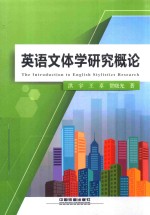
- 作 者:洪宇,王卓,贺晓光著
- 出 版 社:北京:中国铁道出版社
- 出版年份:2016
- ISBN:9787113227029
- 标注页数:162 页
- PDF页数:173 页
请阅读订购服务说明与试读!
订购服务说明
1、本站所有的书默认都是PDF格式,该格式图书只能阅读和打印,不能再次编辑。
2、除分上下册或者多册的情况下,一般PDF页数一定要大于标注页数才建议下单购买。【本资源173 ≥162页】
图书下载及付费说明
1、所有的电子图书为PDF格式,支持电脑、手机、平板等各类电子设备阅读;可以任意拷贝文件到不同的阅读设备里进行阅读。
2、电子图书在提交订单后一般半小时内处理完成,最晚48小时内处理完成。(非工作日购买会延迟)
3、所有的电子图书都是原书直接扫描方式制作而成。
Chapter 1 General Introduction 1
1.1 Definition of Style 1
1.1.1 Language 1
1.1.2 Style 2
1.2 Definition of Stylistics 4
1.3 Development of Modern Stylistics 8
Chapter 2 General Theories of Stylistics 10
2.1 Types of Stylistic Theories 10
2.1.1 Formal Stylistics 11
2.1.2 Functional Stylistics 12
2.1.3 Discourse/Text Stylistics 14
2.2 Models of Stylistics 15
2.2.1 The Sketch of Modern Linguistics 15
2.2.2 Models of Linguistic Stylistics 19
2.3 Three Views on Style 29
2.3.1 Style as Deviance 30
2.3.2 Style as Choice 32
2.3.3 Style as Foregrounding 34
Chapter 3 Grammar and Literary Style 37
3.1 Introduction 37
3.2 Definition of Grammar 38
3.3 Prescription and Description 39
3.4 Morphology and Syntax 40
3.5 Word Classes 43
3.5.1 Identifying Word Classes 44
3.5.2 Open and Closed Class Words 46
3.6 Describing Noun and Verb Phrases 47
3.6.1 The Noun Phrase 48
3.6.2 The Verb Phrase 49
3.6.3 Non-finite Verb Phrases 50
3.7 Describing Sentences 52
3.7.1 Sentences and Clauses 52
3.7.2 Simple and Complex Sentences 53
3.8 Foregrounding and Grammatical Form 56
3.9 Analysis of Grammar:Checklist 59
Chapter 4 Meaning 61
4.1 Introduction 61
4.2 Semantics 61
4.2.1 Gaps and Overlaps 62
4.2.2 Opposites 63
4.2.3 Hyponyms and Superordinates 64
4.3 Context 65
4.3.1 Deixis 66
4.3.2 Homonyms 67
4.3.3 Other Similar Texts/Discourses 67
4.3.4 Prior Knowledge 68
4.4 Register 69
4.5 Literal Language and Figurative Language 71
4.5.1 Similes 72
4.5.2 Metaphor 72
4.5.3 Simile versus Metaphor 74
4.5.4 Explicit and Embedded Metaphors 75
4.5.5 Types of Metaphor 77
4.5.6 Metonymy 82
4.5.7 Synecdoche 82
4.6 Metaphor and Language Change 83
4.7 Functions of Figurative Language Use 84
Chapter 5 International Business 85
5.1 Semantic Features 85
5.1.1 Correctness and Completeness 85
5.1.2 Clearness and Conciseness 86
5.1.3 Consideration and Courtesy 87
5.2 Grammatical Features 87
5.2.1 B Sentence Structure 87
5.2.2 Use of Voices 88
5.2.3 Use of Affirmative Sentences 89
5.2.4 Inverted Sentences 89
5.3 Lexical Features 89
5.3.1 Concrete and Natural Words 89
5.3.2 Technical Terms and Abbreviations 90
5.3.3 Brief and Common Words 90
5.3.4 Avoiding Clichés 91
5.4 Graphological Features 92
5.4.1 Capitalization 92
5.4.2 Arrangement of Typesetting 92
Chapter 6 Computer and Internet 95
6.1 Computer Language 95
6.1.1 Lexical Features 96
6.1.2 Grammatical Features 98
6.2 Internet Language 99
6.2.1 Semantic Features 100
6.2.2 Grammatical Features 101
6.2.3 Lexical Features 102
6.2.4 Graphological Features 107
Chapter 7 The English of Conversation 110
7.1 Necessity of Studying Speech 110
7.2 Necessity of Studying Conversation 110
7.3 Object of Study 110
7.4 An Adapted Way of Transcription 111
7.5 General Features 111
7.6 Stylistic Features in Terms of Levels of Language 113
7.6.1 Grammatical Features 113
7.6.2 Lexical Features 115
7.6.3 Phonological Features 118
7.6.4 Semantic Features 119
7.7 Summary & Other Kinds of Conversation 120
7.8 Discussion about Telephone Conversing 120
Chapter 8 News Report 121
8.1 Semantic Features 122
8.2 Text Structure 122
8.2.1 Headline 123
8.2.2 Guide 125
8.2.3 Main Body 126
8.3 Grammatical Features 129
8.3.1 Meaning Contraction 129
8.3.2 Objectivity 130
8.3.3 Concreteness and Detailedness 130
8.4 Lexical Features 131
8.5 Graphological Features 131
Chapter 9 The English of Public Speech 133
9.1 Scope of Public Speech 133
9.2 A Sample Text for Analysis 133
9.3 General Features of Public Speech 135
9.4 Stylistic Features of Public Speech 135
9.4.1 Grammatical Features 135
9.4.2 Lexical Features 137
9.4.3 Phonological Features 138
9.4.4 Semantic Features 140
Chapter 10 Legal Documents 144
10.1 Function and Style 144
10.2 Grammatical Features 145
10.2.1 Basic Sentence Structure and Process Types 145
10.2.2 Verbal Groups 145
10.2.3 Noun Phrases or Participants 146
10.2.4 Adverbials 147
10.2.5 The Sentence 147
10.3 Lexical Features 148
10.3.1 Sources 148
10.3.2 Classifications and Functions 148
10.4 Graphological Features 149
10.4.1 Punctuation 149
10.4.2 Capitalization 150
10.4.3 The Marking of Text Structures 150
Chapter 11 Science and Technology 151
11.1 Semantic Features 151
11.1.1 The Explicitness of the Relations between Semantic Structures 152
11.1.2 Depersonalization 152
11.1.3 Renationalization 154
11.2 Grammatical Features 155
11.3 Lexical Features 157
11.3.1 Sources 157
11.3.2 Classification 158
11.3.3 Function 158
Bibliography 160
